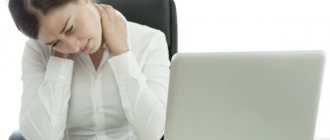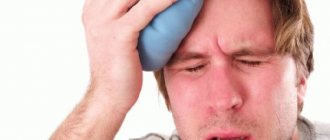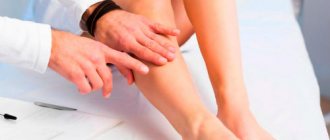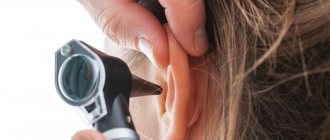What is lumbodynia
Pain with lumbodynia can be chronic or acute/subacute, but in any case it is caused by spinal pathology. Lumbodynia syndrome is considered a sign of osteochondrosis of the lumbar spine, although often with this diagnosis there may be no pain at all. The severity of pain can vary and depends on the individual and a combination of a number of factors. It occurs mainly in people of working age (25-45 years).
Lumbar pain can be localized only on one side or on both (right-sided, left-sided, symmetrical). It most often worries in the lower lumbar region and can radiate to the gluteal region (one or both buttocks).
Treatment
Treatment methods for lumbodynia are selected depending on the reasons that caused it and the stage of the disease. However, they are aimed not only at eliminating them, but also at relieving pain and relieving muscle spasms. Most often, the following treatment methods are used for lumbodynia:
| Methodology | Description |
| Therapeutic measures |
|
| Treatment with medications |
|
| Traditional methods |
|
| Surgical techniques |
|
Operations for diseases of the spine
- Cost: 100,000 - 250,000 rubles.
- Duration: 40-60 minutes
- Hospitalization: 2-3 days in hospital
More details
Kinds
Vertebrogenic lumbodynia is the main manifestation of the chronic form of osteochondrosis (lumbar zone) and is more often characteristic of men. Can have any duration (last from several weeks/months to several years). If the cause of pain is diseases of the intervertebral disc (herniation, protrusion), then lumbodynia is called discogenic.
In addition to the above, “classic” one, there are other types. It can be combined with nagging pain in one or both legs (sciatica), in which case it is called lumboischialgia. (left-handed or right-handed). Depending on the distribution (on one or both limbs). Accompanies the non-radicular phase of lumbar osteochondrosis.
When the pain is intensified not only by movements, but even by the slightest activity, such as talking, sneezing, bending over, then this type is called lumbodynia with muscular-tonic syndrome. Often, there is a moderate curvature of the spine, causing pronounced reflex tension in the lower back muscles (bilateral or unilateral), which provokes pain.
The most common causes of chronic lumbodynia
Myofascial syndrome
– can develop against the background of a degenerative-dystrophic process in the spine or independently of it: with prolonged stay in an uncomfortable position, overload or overstretching of muscles, injury, prolonged immobilization. Psychological factors, such as prolonged stress, anxiety, and depression, also play a huge role in the occurrence and maintenance of myofascial syndrome. This syndrome is based on the formation of trigger points that cause not only local, but also referred pain to a strictly defined area. A trigger point is a painful local tightening of muscle fibers that limits muscle contractility. An active trigger point, especially at the lumbar level, can cause sharp pain, described by many patients as shooting in the lower back. There are also latent trigger points that are masked by active ones; they cause local muscle tension and muscle dysfunction. In the area of muscle tension, numbness and crawling may be observed. A long-existing trigger point promotes the appearance of secondary trigger points, thereby increasing the area of pain.
Intervertebral disc herniation.
When a hernia forms, the outer layer of the fibrous ring ruptures, and then the nucleus pulposus of the disc enters the lumen of the spinal canal or intervertebral foramen. Pain syndrome with a herniated disc appears due to irritation of pain receptors in the outer layer of the fibrous ring and the posterior longitudinal ligament of the spine. All this causes a reflex contraction of the segmental muscles at this level, which is protective in nature - it stabilizes the damaged spinal motion segment (SMS). But over time, the protective role is lost, and this spasm becomes an independent factor that maintains pain. In addition, when a hernia prolapses into the intervertebral foramen, it can have an indirect effect on the spinal nerve root through swelling of the adjacent soft tissues, or its direct compression by a disc herniation with the formation of radiculopathy. The pain will be localized not only at the lumbar level, but also radiate to the lower limb. In addition to pain, in the area of innervation of the affected root there will be a decrease in muscle strength, a decrease or loss of reflexes, and impaired sensitivity.
Spinal stenosis.
The main causes of stenosis at the lumbar level are herniation or protrusion of the disc, spondylolisthesis (displacement of one vertebra in relation to the adjacent vertebra), osteophytes (overgrowth of bone tissue), hypertrophy of the yellow ligament of the spine. With stenosis, compression occurs on the roots of the cauda equina and the vessels that feed it. The main manifestation of stenosis, in addition to long-term pain in the lower back, is neurogenic intermittent claudication, which appears when walking and standing and is accompanied by difficult-to-localize pain in the legs, weakness in the lower leg muscles (legs begin to give way) and numbness. Typically, such patients need to lean forward or sit down for the symptoms to regress. Symptoms may worsen when going downhill or up stairs. Sometimes patients who have difficulty walking 100-200 meters can easily cover long distances on a bicycle.
Spondylolisthesis and spondylolysis.
Spondylolisthesis is a slipping of the overlying vertebra relative to the underlying one in the ventral direction (forward). From a clinical point of view, two types of spondylolisthesis can be distinguished: isthmus and degenerative spondylolisthesis.
With isthmus spondylolisthesis, spondylolysis is more common, i.e. Non-fusion of the interarticular part of the arch, usually of the 5th lumbar vertebra. Spondylolysis can be either a congenital condition or an acquired one. Acquired spondylolysis develops as a result of excessive load on the vertebra, in which an intraosseous stress zone is formed, which leads to a change in the structure of the bone tissue at this level, and a fracture of the interarticular arch occurs.
Degenerative spondylolisthesis develops due to loosening of bone tissue and occurs mainly in older women. Typical localization is the L4-L5 segment.
As a rule, isthmic spondylolisthesis is asymptomatic throughout life, in rare cases it manifests itself as pain in the sacrum, which can radiate to the thigh. Degenerative spondylolisthesis can lead to spinal stenosis and manifest as the intermittent neurogenic claudication described above.
Causes of lumbodynia
Low back pain (lumbodynia), both chronic and acute, is most often caused by pathological processes (degenerative-dystrophic) in the spine, especially in the lumbar region. In addition to osteochondrosis, lumbodynia is caused by its complications, such as protrusion, spondylolisthesis, intervertebral hernia, spondyloarthrosis, spondylosis.
The mechanism of lumbodynia is based on irritation of the nerves (especially sinuvertebral). Pain is especially pronounced with cracks in the fibrous ring. Also the cause is abnormalities in the development of the lumbar spine.
Pain can occur after a single physical overload, lower back injuries, hypothermia, stress, sudden turns of the body, hypothermia, exposure to drafts, prolonged exposure to an uncomfortable or monotonous position. Moreover, lumbodynia can manifest itself not only after a few days or weeks, but even several months after the provoking factor.
The risk group also includes those who are overweight, have certain chronic diseases, have infectious diseases, workers in hazardous industries, those who experience increased stress, lead an adynamic lifestyle, or are in an uncomfortable or the same body position for a long time.
Prevention of lumbodynia
To prevent lower back pain, we recommend doing fitness, swimming, and cycling. Walk more, walk in the fresh air. Try not to get too cold and gain weight. To maintain the health of the spine, it is better to sleep on an orthopedic mattress on your side - this position unloads the spine.
To work at the computer, choose a chair with an anatomical shape and lean on the back, this reduces the load on the spine. Don't lift heavy weights. When lifting weights, bend your knees, keep your back straight, and lift the load using the muscles of your arms and legs, not your back. Distribute heavy loads in both hands or wear a backpack.
It is also necessary to eat properly, building a diet in such a way that the food you eat contains a sufficient amount of minerals, proteins and vitamin D. It is recommended to avoid common bad habits, such as smoking or heavy drinking of alcohol.
To prevent the occurrence of lumbodynia during pregnancy, it is strongly recommended to wear a support bandage starting from the sixth month.
Symptoms
With vertebral osteochondrosis, lumbodynia is aching in nature and is more pronounced in the morning. May have different durations, decrease or increase during the day. There are provoking factors that increase or decrease the intensity of lumbodynia. For some it is caused by activity, while for others it is its absence; accordingly, opposite actions ease the pain. A combination of these manifestations may occur in the same person.
Pressure on the vertebrae and paravertebral areas in the lumbar area is usually painful. In addition, bending and many other movements are difficult and most often accompanied by pain. Patients have difficulty bending, especially forward, and the angle of inclination of the torso becomes limited. There may be sharp pain in response to palpation of the exit point of the sciatic nerve on the thigh.
Doctors explain the subsidence of pain in the lying position by reducing the load on the lumbar intervertebral discs. Patients intuitively or consciously find the most comfortable position (in which the pain is least pronounced). Most often, this is a position lying on your side with your legs bent.
At first, there is moderate lumbodynia, gradually the pain intensifies, but does not reach the same degree of severity as with lumbar pain (lumbago), also called acute lumbodynia. Patients can move around and do work, but the quality of life is significantly reduced.
Symptoms of lumbodynia - how to recognize the disease?
Acute lumbodynia usually appears on one side. The pain intensifies if you stand or sit, and disappears if you lie on your side. Your lower back hurts even if you perform normal movements, such as washing your face. The pain gets worse when you cough or sneeze; bending over is difficult and painful. Muscles get tired quickly if you sit or stand. You have to change your position frequently to reduce the pain.
The pain increases by the 4-5th day of the attack. Treatment should begin as soon as they appear. Otherwise, this condition will drag on for weeks. If the process becomes chronic, the sacrum, buttock, and leg already hurt. You shouldn’t let it get to this point - chronic lumbodynia takes much longer and is more expensive to treat.
Diagnosis of lumbodynia
Lumbodynia can be diagnosed in different ways. A neurologist diagnoses this disease. The most common is a clinical examination and questioning of the patient, combined with static and dynamic examination of the spine, as well as manual diagnostics. Additionally, the organs of the pelvic and abdominal cavities are examined to exclude diseases that are a source of referred pain. In addition, MRI, radiography, and ultrasound diagnostics will not be superfluous. During the examination, lumbodynia is differentiated from myositis of the spinal muscles and pathologies of the hip joint.
IMPORTANT! Lumbodynia is a serious symptom that can tell a person about significant problems in the lumbar spine, ranging from inflammatory phenomena to destructive diseases. That is why, if you have lumbodynia, you cannot self-medicate, but you should definitely consult a specialist!
Experienced doctors at the Kuntsevo Medical and Rehabilitation Center will conduct a thorough diagnosis and understand the causes of the symptom. A treatment plan for the patient will then be drawn up. Make an appointment with our doctor and take a step towards getting rid of lumbodynia!
Sign up
Diagnostics
A thorough history and physical examination can usually diagnose life-threatening conditions that may be associated with low back pain. The patient describes the onset, intensity of pain, duration of pain and other symptoms, any restrictions in movement; a history of previous episodes of pain or the presence of medical diseases that may be associated with pain. The doctor examines the neurological status to determine the possible cause of the pain and, if necessary, prescribes an examination plan using both instrumental and laboratory research methods.
X-rays can detect gross changes in bone tissue, such as spinal injuries or bone destruction.
Computed tomography is significantly more informative than radiography and allows you to obtain images in conditions such as disc herniation, spinal canal stenosis, and the presence of tumors.
Magnetic resonance imaging (MRI) is the most reliable method of visualizing morphological changes and allows you to diagnose degenerative changes, changes in muscles, ligaments, nerves, and blood vessels.
EMG and ENMG make it possible to determine functional disorders of the nervous system and determine conduction disorders in nerve fibers and muscles.
Scintigraphy is used to diagnose and monitor infections and tumors and is based on the difference in absorption of a radioactive substance by pathological tissue compared to healthy tissue.
Thermography is a technique that uses infrared sensors to measure small changes in temperature between two sides of the body or the temperature of a specific organ. Thermography can be used to determine root compression.
Ultrasound allows you to visualize the internal organs of the abdominal cavity and pelvis, and this research method is often used for the differential diagnosis of lumbodynia. An ultrasound examination can also determine damage to ligaments, muscles, and tendons.
Laboratory tests are widely used to diagnose inflammatory processes, infections, and rheumatoid diseases.
Treatment with manual therapy
You can get rid of lumbodynia only by eliminating the causes that caused it. This type of treatment can be considered complete. In other cases, the help will have a temporary effect and after some time, lumbodynia will appear again, and if the treatment was inadequate, it will intensify or recur. It is important to find a good chiropractor, otherwise you may not only not be cured, but even make things worse.
Since the main cause of lumbodynia is considered to be vertebral osteochondrosis, the cause of which, in turn, is improper functioning of the spine, it is not lumbodynia that should be treated, but osteochondrosis. In addition, by getting rid of osteochondrosis, you will protect yourself from the occurrence of its complications, such as hernias and disc protrusions.
Manual therapy is considered one of the most effective ways to eliminate problems in the spine. It is especially effective in combination with the subsequent implementation of a complex of physical therapy (physical therapy). All this not only improves the condition, but also stimulates recovery processes, thanks to which the course of the disease can sometimes not only be stopped, but also reversed.
The number of procedures is prescribed individually, based on the patient’s health characteristics, stage of the process, complications, and concomitant diseases. It is also necessary to perform exercise therapy to consolidate the achieved result and maintain it after treatment.
Treatment of lumbodynia
The same symptoms may be signs of different diseases, and the disease may not proceed as it is described in the textbook. Do not try to treat yourself - consult your doctor.
According to the latest international recommendations, bed rest for severe pain should not exceed 3 days. It is necessary to gradually restore motor activity as early as possible, without exceeding the pain threshold. Dosed physical exercises are not only safe for your back, but also beneficial. In the acute period of the disease, it is possible to use an orthopedic corset of medium rigidity to relieve pain.
It must be understood that with a chronic process, treatment will be long and complex - the joint work of a doctor - a vertebroneurologist, a psychotherapist and other related specialists must be carried out.
Our clinic has accumulated extensive experience working with patients experiencing back pain. We treat pain both in the acute period and prevent exacerbations in the future.








